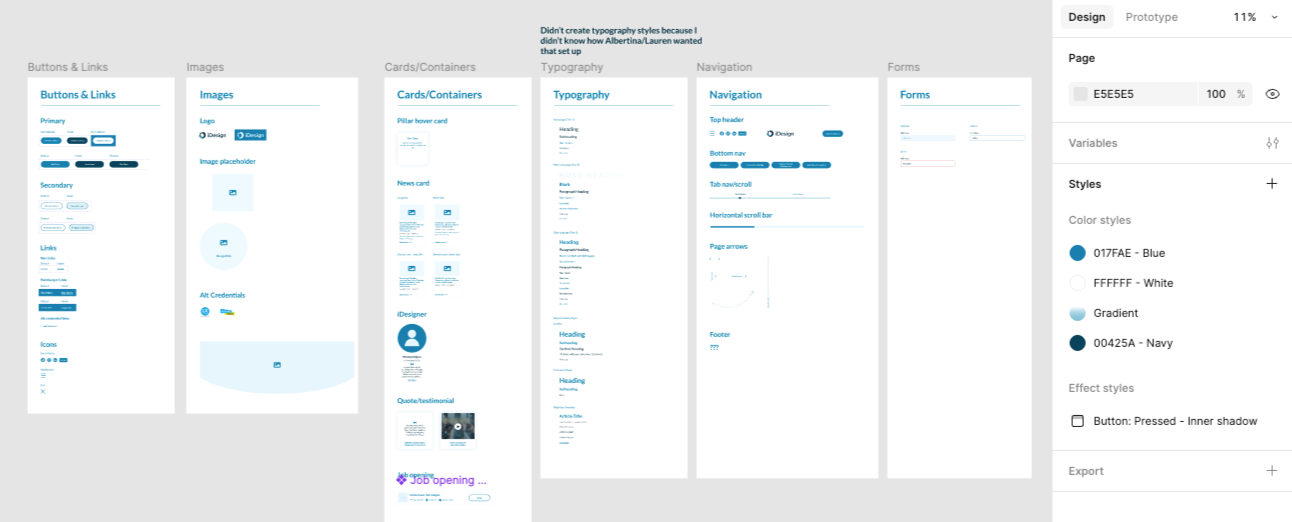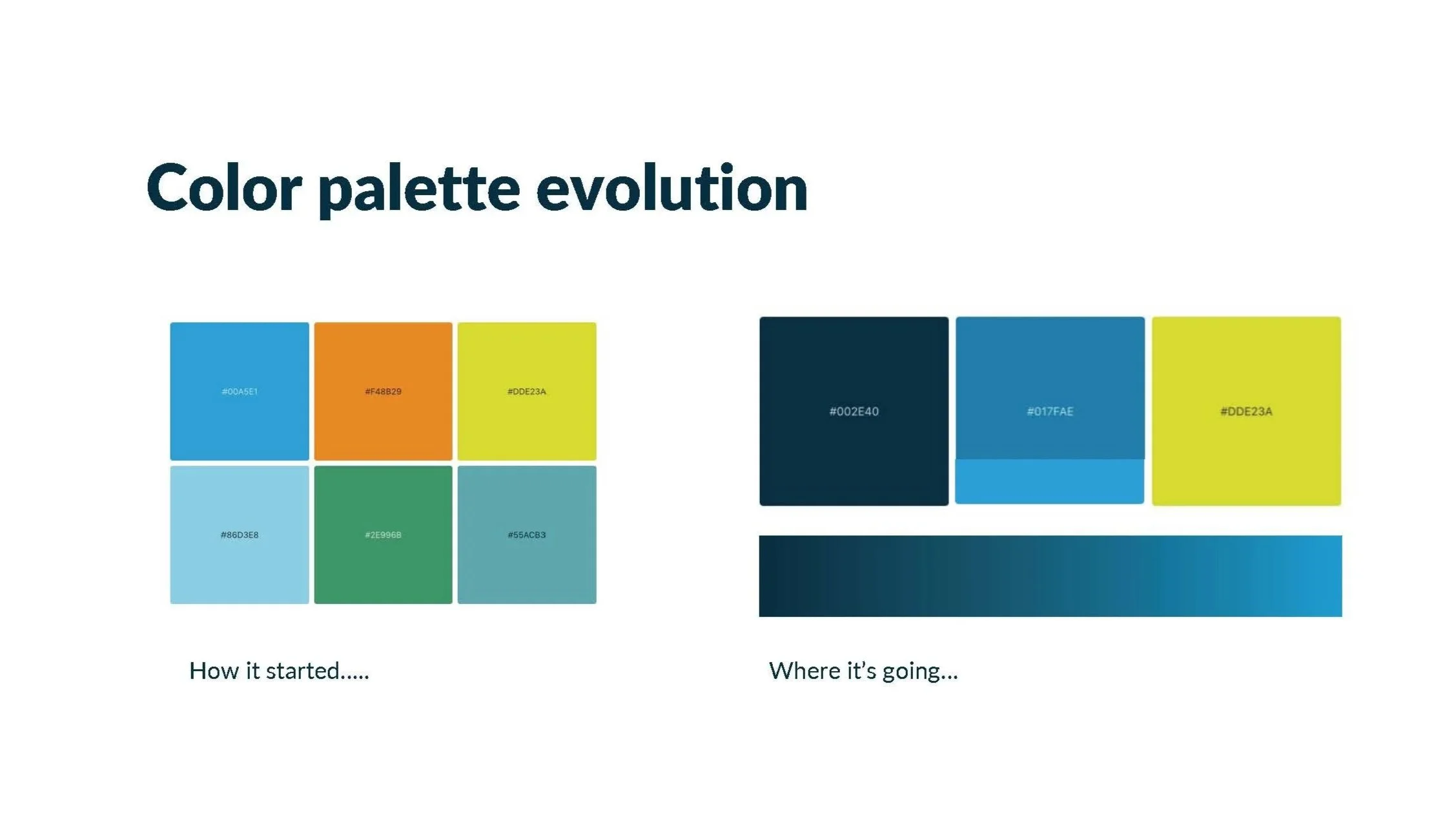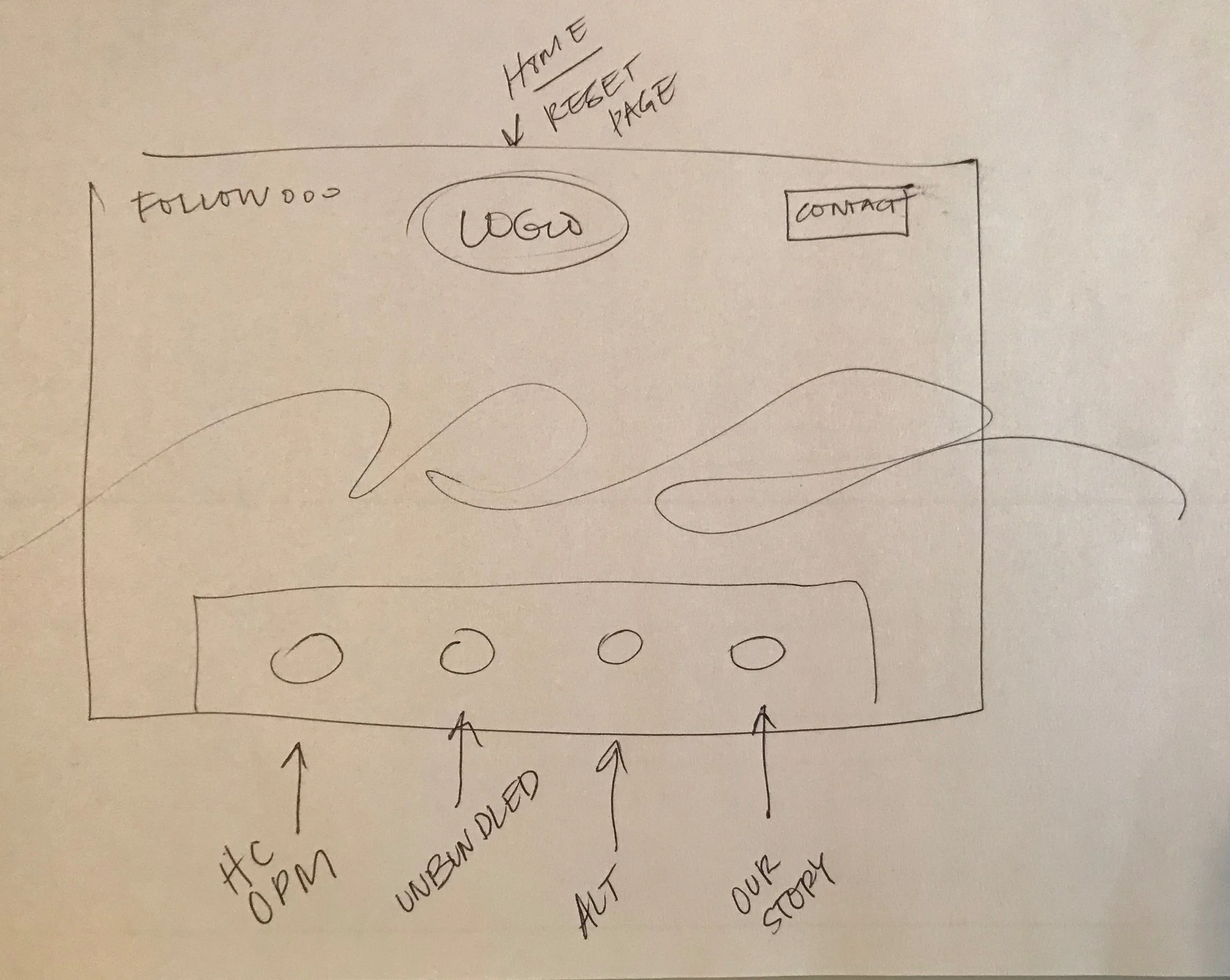A collection of strategic initiatives, brand systems, and cross-functional projects I’ve led—from rebrands and product launches to design operations and team growth. Each project highlights how I approach creative direction with clarity, collaboration, and long-term impact in mind.
iDesign In-House Rebrand | 2020 - 2021
Role:
As Creative Director, I led the strategy, design direction, and cross-functional collaboration behind iDesign’s internal rebrand. This included redefining our visual identity, mentoring early-career designers, and establishing new design tools and systems to ensure long-term scalability and accessibility. My role extended beyond creative execution into team growth, process optimization, and digital infrastructure planning.
Objective:
To modernize iDesign’s brand identity to reflect the company's growth from a services-only instructional design firm to an innovation-driven organization offering SaaS products and integrated solutions. The rebrand needed to unify our identity, support cross-functional storytelling, and set the stage for future product launches and partner-facing communication.
Approach:
Strategic Design Oversight | Developed a flexible, modular brand system that included updated logo forms, an ADA-compliant color palette, custom typography selections, iconography, and layout templates. All decisions were rooted in clarity, usability, and accessibility.
Accessibility-Led Visual Redesign | Led a comprehensive accessibility review of the brand system with a team of interns and junior designers, ensuring the logo, color usage, and type styles met WCAG 2.1 AA/AAA standards. This involved contrast testing, mobile-friendly scaling, and legibility evaluation across formats.
Mentorship in Action | Mentored a group of creative interns through the logo redesign process, giving them hands-on experience in research, critique, and system-level thinking. Several interns contributed to core brand deliverables and went on to full-time roles in the field.
Figma Implementation + Design System Build | Introduced Figma to the creative tech stack, setting up shared libraries and collaborative workflows. Built the iDesign Design System within Figma, which became the foundation for internal websites, brand templates, and future SaaS product design (including Align).
Internal Brand Launch + Adoption Strategy | Designed and launched an internal microsite to house brand guidelines, system documentation, downloadable assets, and tutorial content. This enabled full organizational adoption across marketing, partner engagement, proposal development, and product teams.
Budget & Vendor Leadership | Managed a lean budget ($26K of a $70K allocation), maximizing internal capabilities while maintaining high-quality output and stakeholder alignment.
Outcomes:
A scalable, accessible brand system adopted across all internal and external channels, including web, print, product, and partner materials.
Positioned iDesign for future product launches (e.g., Align) with a clear brand architecture and reusable design foundations.
Created a shared Figma-based design system, enabling efficiency and collaboration across teams.
Empowered a team of interns with real-world design experience and portfolio-ready contributions.
Delivered the rebrand on budget while elevating iDesign’s position in a competitive education and SaaS landscape.
Launch of Brand Architecture & SaaS Product Identity (Align) | 2023 - ongoing, with launch of additional SaaS features
Your Role
As Creative Director, I led the design strategy and brand system architecture supporting iDesign’s expansion into SaaS, including the visual identity and positioning of Align—our internal curriculum mapping tool. This project extended beyond design execution into product planning, organizational branding, and team development. A key component of this work involved creating space and mentorship for one of my designers to grow into a UX/UI role, ultimately leading to their transition into a full-time product design position at iDesign.
Objective
As iDesign evolved from a service-based instructional design company to a multi-solution partner with SaaS offerings, we needed a clear brand architecture that could differentiate our internal tools while preserving cohesion under the iDesign umbrella. Align, our first official SaaS product, required a distinct identity and user-facing presence that complemented iDesign’s core values and visual language.
Approach
Brand Architecture Planning | Defined the relationship between iDesign’s master brand and sub-brands like Align. Developed naming, visual hierarchy, and messaging structure that positioned Align as a powerful, standalone tool while still rooted in iDesign’s reputation and instructional design ethos.
Identity Development for Align | Oversaw the design of Align’s logo, color system, typography, and interface patterns, ensuring consistency with accessibility standards and long-term scalability. Built flexible brand extensions and templates to support marketing, sales, and product use cases.
Cross-Functional Collaboration | Worked closely with the product and engineering teams to guide early product visuals and UX direction. Aligned marketing, content, and design efforts to ensure consistency across web presence, demos, internal onboarding, and partner-facing decks.
Design System Foundations | Introduced and scaled Figma libraries that housed UI elements, brand components, and documentation, paving the way for more efficient product design workflows. This groundwork evolved into the early stages of a formal product design system for Align.
Team Development & Role Expansion| Identified a growing opportunity in UX/UI within our internal product roadmap and created a new pathway for one of our in-house designers to explore product design. Through mentorship, skill development, and collaborative design work, they transitioned into a full-time UX/UI role supporting Align and future tool development at iDesign.
Outcomes
A clear and flexible brand architecture is now used for Align and future product initiatives, allowing iDesign to differentiate tools without fragmenting its visual identity.
Launched the Align visual identity system, enabling strong early engagement with partners and stakeholders during demos, proposals, and onboarding.
Oversaw the design and launch of the Align acquisition page with additional promotional print marketing materials for sales/conferences.
Established design system tools in Figma that improved product-to-marketing design alignment and streamlined handoffs.
Supported team growth by creating a role pathway and career opportunity for a designer to transition into UX/UI—now contributing directly to internal product evolution.
Creative Process Evolution | 2022-23 (ongoing with AI integrations)
Your Role
As Creative Director, I led a full-scale redesign of our creative operations to better support a growing team, increase efficiency, and align design workflows across cross-functional teams. This initiative included process analysis, tool migration, automation, and team development—laying the groundwork for a more scalable and transparent creative function. As the foundation stabilized, I also initiated a leadership transition, promoting our Graphic Design Coordinator to Graphic Design Manager to help lead the next phase of operational growth.
Objective
To evolve iDesign’s creative request, review, and delivery pipeline in response to increased demand, inefficiencies with legacy tools, and the need for better internal visibility. This evolution aimed to simplify the process for requesters, reduce turnaround time, increase collaboration, and create space for shared leadership within the creative team.
Approach
Tool & Workflow Redesign | Retired Smartsheet as the team’s project management tool and migrated to Asana. Built customized workflows for various creative request types and trained both the Creative team and internal partners on how to submit and track requests. Introduced automation for task assignments and due dates to reduce friction and follow-up.
Integrated Tech Stack | Implemented a fully integrated ecosystem connecting Asana with Google Drive (for asset storage and versioning) and Pageproof (for proofing and approvals). This created a centralized workflow that minimized tool-switching, reduced redundant communication, and improved transparency across the lifecycle of a design request.
Future-Proofing with AI | Instead of layering on third-party AI tools, we thoughtfully explored how AI could complement the tools already in our stack. This ensured scalable, secure integration that could grow with evolving tech. From automating repetitive layout tasks to enabling creative idea generation, AI became a collaborative assistant—not a replacement.
Documentation & Change Management | Created internal documentation and hosted training sessions to ensure team-wide understanding and adoption. Provided flexibility within the structure to support different types of projects while reinforcing consistency.
Team Development & Delegation | With the process stabilized and leadership needs evolving, I promoted our Graphic Design Coordinator to a Graphic Design Manager role. This promotion created space for shared leadership within the Creative team, supported continuity, and allowed me to begin delegating day-to-day operational oversight. It also provided a growth path for a strong internal contributor ready for more strategic responsibility.
Outcomes
Migrated the team from Smartsheet to a fully integrated Asana-based workflow, resulting in clearer task management and automated steps that reduced overhead.
Reduced tool fatigue and cut technology costs by eliminating the legacy DAM and consolidating to tools already widely used across the company.
Significantly improved cross-functional visibility into project status and timelines, enabling smoother collaboration with Marketing, Learning, and Partner teams.
Improved team autonomy and creative delivery through clearer expectations, flexible systems, and centralized resources.
Introduced AI in a sustainable, integrated way that supports rather than replaces creative judgment
Created internal leadership growth by transitioning operational oversight to a newly promoted Graphic Design Manager, preparing the team for its next phase of scale.
Creative Internship Program | 2020–Present
Your Role
As Creative Director, I built iDesign’s Creative Internship Program from the ground up. The program was designed with a clear purpose: to offer hands-on design experience and personalized mentorship in a way that I wish I’d had earlier in my career. I shaped this initiative to give designers—especially those changing careers or still in school—a chance to develop real-world skills, grow creatively, and learn in a supportive but challenging environment.
Objective
To create a growth-centered internship that prioritizes mentorship, accessibility, and professional development—offering more than just a paycheck, but a meaningful opportunity to explore and expand creative potential.
Approach
More Than Freelance Work | I intentionally designed the program to attract individuals who are excited to learn—not just complete tasks. After years of working as a freelancer myself, I recognized how many contractors are simply seeking deliverables, not development. I wanted to change that dynamic and build something different—something I would have wanted to be part of as a young designer.
Trial by Fire, but with a Safety Net | Interns were given challenging, real assignments—ranging from branding to accessibility audits to web and slide design—but always within a “safe-to-fail” space. I believe the best learning happens by doing, so we encouraged experimentation, feedback loops, and skill-building across tools like Adobe Creative Suite, Figma, and Pageproof.
School Comes First | Many of our interns were still in school. I made it clear that academic commitments come first. Saying “no” to a project didn’t mean the door closed; we emphasized that the opportunity to learn would continue. I wanted to counter the scarcity mindset that often leads young designers to overextend themselves out of fear they won’t get more work in the future.
Growth by Design | Interns weren’t siloed. They collaborated with the full Creative Team, contributed to milestone projects like the 2021 rebrand and accessibility updates, and gained visibility into the complete project lifecycle. They left with experience in real processes, platforms, and client expectations—not just portfolio samples.
Mentorship with Real Outcomes | I met regularly with each intern to support their growth, offer feedback, and help them discover their own creative strengths. This was not just about execution—it was about identity, confidence, and stepping into their next professional chapter.
Outcomes
Supported 12+ interns since 2020, across design, UX, and strategy disciplines
Several interns continued as contractors at iDesign, gaining paid experience post-internship
Others launched design careers in agency or in-house roles, or pursued graduate design programs
Two former interns now hold full-time positions at iDesign as Graphic Design Manager and UX/UI Designer, respectively
Contributed to major company initiatives, including the internal rebrand, SaaS launch branding, and accessibility standards updates
Created a culture of mentorship, flexibility, and creative curiosity, reinforcing iDesign’s commitment to thoughtful, inclusive design
Developed a repeatable internship structure and talent pipeline that continues to benefit both the interns and the organization
Marketing Website Strategy & Launch for OPM Partners | 2018 - Present
Your Role
Since 2018, I have led the creative direction, design, and execution of microsites and integrated marketing materials for more than eight Online Program Management (OPM) partners. This work ensures each site and asset reflects both iDesign’s brand standards and the unique identity of the partner institution, while delivering accessible, high-impact marketing to prospective students and stakeholders.
Objective
Deliver comprehensive, on-brand digital and print marketing solutions that increase visibility, streamline program information, and drive enrollment for diverse academic programs—particularly large-scale, multi-program portfolios such as full nursing degree pathways (BSN to DNP).
Approach
Custom Microsite Development | Designed and launched responsive microsites/ acquisition pages that are tailored to each partner’s brand guidelines, ensuring an intuitive and WCAG-compliant user experience.
Full Marketing Ecosystem Support | Extended the brand experience beyond websites to include printed program pages, social media graphics, employer partnership materials, and event collateral.
Specialized Program Support | Developed dedicated clinical program branding and materials, ensuring that the unique needs of nursing and other hands-on programs were met with clarity and professionalism.
Cross-Functional & Partner Collaboration | Partnered with internal marketing teams, student success coaches, and external stakeholders to ensure all touchpoints—from web to print—remained consistent with the partner’s identity.
Scalable Process | Established repeatable workflows for launching new partner sites and marketing assets quickly without sacrificing quality, allowing for faster go-to-market timelines.
Outcomes
Over 10 OPM partner microsites successfully launched, each accompanied by a full suite of supporting marketing materials.
Examples available by request.
Increased inquiry rates through cohesive digital and print strategies that made program pathways easy to understand.
Established a consistent brand experience across online, print, social, and event marketing channels.
Enabled scalable support for partners with multiple academic offerings, streamlining communication and reducing redundant design work.








